Clarissa Reyes, Orchard Systems Advisor, Sutter-Yuba, Butte & Placer Counties
Dr. Themis Michailides, UC Davis Plant Pathologist at Kearney Ag Research and Extension Center
Many walnut growers in the Sacramento Valley have been calling their farm advisor, alarmed by an unusual amount of black nut drop about a month before harvest, along with dark spots at the stylar end of walnut hulls, and black lesions on the sides of walnut hulls. Nut samples were collected by UCCE advisors and analyzed by Themis Michailides to reveal that the end spots were brown apical necrosis (BAN) and blotchy black side lesions were walnut blight. BAN can lead to mold and reduce nut quality and yield, and walnut blight can reduce yield as infected nuts prematurely abort.
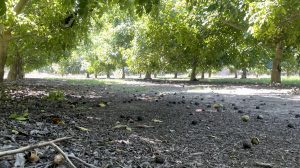
Black nut drop in a Butte county walnut orchard. Photo: Clarissa Reyes, taken Aug 2023
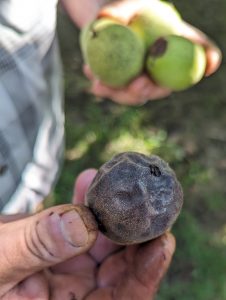
Walnut with a black hull (foreground) and nuts with lesions (background). Photo: Jaime Ott, taken Aug 2023
Blight symptoms can appear on the sides of the hull as patchy dark spots with soft margins or as black lesions with hard margins. Blight is a disease caused by the bacterium Xanthomonas arboricola pv. juglandis. It can infect any green tissue in walnut, and can predispose nuts to insect damage and cause low quality kernels.
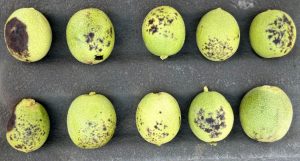
Walnut blight blotches and lesions. Photo: Clarissa Reyes, taken Aug 2023
BAN symptoms begin as a brown spot at the stylar end (the flower tip) of the walnut hull that can grow as the infected internal tissue rots. The BAN tissues most frequently consist of simultaneous infection by walnut blight bacterium that did not successfully enter the shell to infect the kernel and by a complex of fungi that include Alternaria spp., Fusarium spp., Aspergillus niger, Colletotrichum sp. and Phomopsis sp.1 Of these, Alternaria and Fusarium, along with Aspergillus niger, are known to cause kernel mold.
![Green walnut hulls with brown spots on the flower ends of the hulls.]](http://www.sacvalleyorchards.com/wp-content/uploads/2023/10/Photos4-5-261x300.jpg)
Brown spots on the stylar end of hulls are a symptom of BAN. Photos: Clarissa Reyes, taken Aug 2023
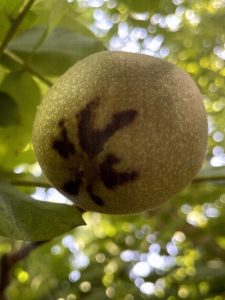
Advanced BAN symptoms. Photo: Luke Milliron, taken Aug 2023
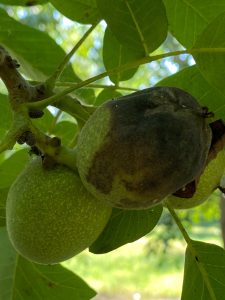
Advanced BAN symptoms. Photo: Luke Milliron, taken Aug 2023
Although these diseases have effective tools for prevention, 2023 presented some conditions that enabled a widespread occurrence of BAN and walnut blight. With very low walnut prices, many growers skipped their usual blight sprays this year. Rain in both early April and early May likely spread inoculum to unprotected tissue (these fungi and bacteria are present to some degree in every orchard, even healthy ones). The Sacramento Valley also experienced unusual summer rain in early June, and then again in August with Hurricane Hilary. This late rainfall could have spread any fungal or bacterial infections that were already present. In addition to rainfall, late-season blight may be caused by sprinkler water hitting hulls during irrigation and is found mostly on low-hanging branches.
If you observed BAN or walnut blight symptoms in your orchards this year, be aware that inoculum can remain for next year. It will be important to apply sprays at the appropriate times next season to avoid further fungal BAN and bacterial blight infections. Preventative blight treatments are typically applied in the spring when precipitation is expected; rotate bactericides with different modes of action based on inoculum/disease history, variety, and weather forecasts. For mold management, field experiments have shown that applications of Merivon at 6.5 fl. oz/ac (FRAC group 7 and 11, a.i. fluxapyroxad and pyraclostrobin, respectively) or Rhyme at 7.0 fl. oz./ac (FRAC group 3, a.i. flutriafol) at three weeks prior to hull split can control mold-causing fungi.2
1 Belisario, A., Santori, A., Potente, G., Fiorin, A., Saphy, B., Reigne, J. L., Pezzini, C., Bortolin, E., & Valier, A. (2010). Brown Apical Necrosis (BAN): A Fungal Disease Causing Fruit Drop of English Walnut. Acta Horticulturae, 861, 449–452. https://doi.org/10.17660/ActaHortic.2010.861.63
2 Mention of pesticides and spray timings do not constitute a pesticide recommendation; it is merely the sharing of research results. Always follow the pesticide label and consult with your PCA.


Leave a Reply